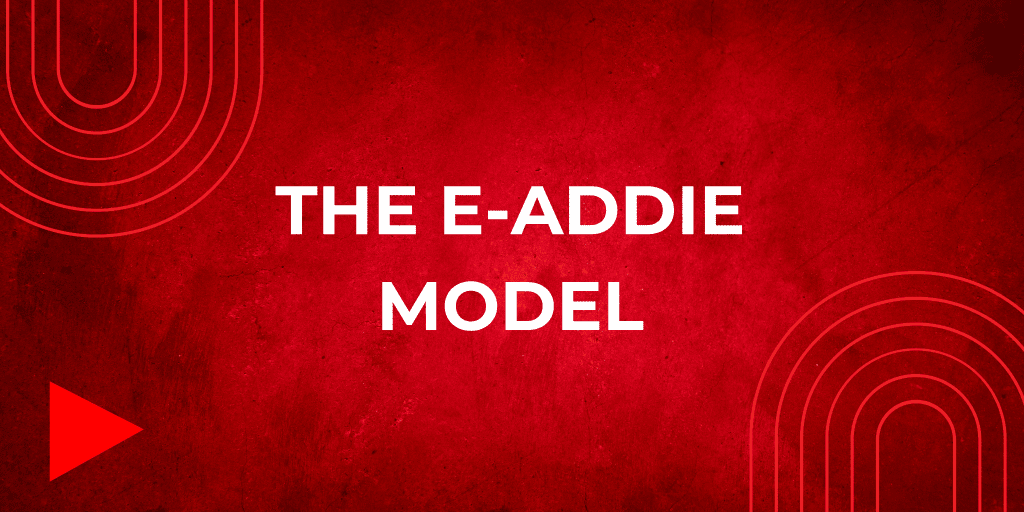
Our E-ADDIE model is our bespoke version of the widely used design methodology in the instructional design and eLearning industry. The traditional model, which stands for Analysis, Design, Development, Implementation and Evaluation, is a systemic approach to the design and development of instructional materials as well as video production processes. Anderson Studios adds an extra ‘E’ for engagement.
We strongly believe that we must engage our client’s needs and requirements effectively from the get-go. For more information about what exactly our E-ADDIE model is, read our take on it here.
Join us as we provide best practices for implementing our E-ADDIE Model into your instructional design and eLearning projects.
Let’s Break It Down
The E-ADDIE model guides us through pinpointing needs to measuring success, with a focus on ensuring that the training engages but also delivers real results. Embracing this fundamental framework means adopting a mindset that evaluates training efforts and makes each learning experience valuable. To track your team’s performance, we’ve created a ‘cheat sheet’, breaking down each phase and providing your content creation studio with a quick-reference checklist.
Engage
- Identify the client’s needs and wants
- Develop objectives for the project
- Engage with regular feedback from the client throughout the project process
Analyse
- Usually makes up 10% of the budget
- Develop learner profiles
- Identify learning spaces and devices
- Research learning resources
- Determine delivery and assessment strategies
- Obtain consensus before moving on to ‘Design’
Design
- Usually makes up 36% of the budget
- Develop a storyboard of the design
- Plan and test this by using prototypes
- Identify the capacity of the network
- Design online learning spaces
- Explore and refine technology options
- Consider using repositories
- Obtain consensus before moving on to ‘Development’
Development
- Usually makes up 35% of the budget
- Conduct testing
- Ensure that you’re meeting security, backups and access requirements
- Confirm licensing, copyrights and accessibility
- Obtain consensus before moving on to ‘Implementation’
Implementation
- Usually makes up 4% of the budget
- Provide tools for learners
- Conduct delivery and assessments
- Create and provide an entry point for learners
- Prepare instructors for eLearning content
- Obtain consensus before moving onto the final stage, ‘Evaluation’
Evaluation
- Usually makes up 7% of the budget
- Collect, analyse and interpret data
- Share results
- Obtain feedback and identify areas for improvement
- Update improvement areas and circle back
How to Incorporate the E-ADDIE Model in 5 Steps
In conjunction with our ‘cheat sheet’, transform your content ideas into a powerful learning experience in five steps.
Step 1
Identify what your course aims to solve and get to know your target audience–what they already know, what they need to learn and how they learn best. Analyse skills gaps to set clear, measurable learning objectives.
Step 2
Using insights from your analysis, start work on designing the course structure. This involves outlining course modules, and lesson plans and identifying activities and assessments that are best suited to achieving learning objectives. Think of this step as your blueprint and align it with your client’s goals.
Step 3
Utilise a mix of text, video, interactive elements and real-world simulations to develop engaging content that suits your design well. Ensure that your content is accessible and engaging by implementing instructional design principles. You can read our take on this here.
Step 4
It’s time to launch the course you’ve created for learners. This may include enrolling participants and scheduling sessions, simultaneously ensuring that all technology is up and running smoothly. Emphasis on providing support for learners is key here as you may need to make real-time adjustments as learners navigate through the course and provide feedback.
Step 5
Time to measure the effectiveness of the course. Collect, analyse and interpret data collected throughout the project. Is the course material representative of your target audience? Did the course meet learning objectives? Has the content ensured representation and inclusion of diverse perspectives, identities and experiences? Which areas need improvement? Feedback gathered through surveys, quizzes and discussions is sure to provide a few answers. Use this to refine and improve the course.
Get in Touch
We understand learning and education. Anderson Studios is deeply invested in online learning, bringing the full force of our high-tech equipment and experience in video, animations, motion graphics, instructional design and live-streaming learning events to each and every project.
That means you get the best team of specialist and outsourced experts working on your online education content creation objectives, every time.
Get content that clearly educates, explains and trains, engages and inspires. The crew at Anderson Studios is standing by to make content that achieves your digital transformation goals and that makes learning easier.

